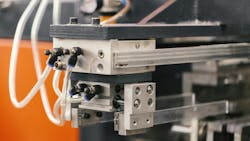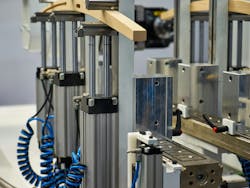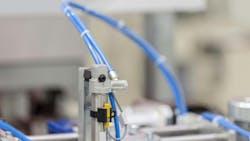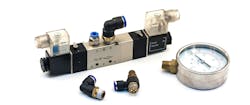Advancements in Pneumatics Meet Modern Industrial Machinery Demands
Key Highlights
- Energy efficiency and smart diagnostics are key drivers shaping pneumatic system designs for industrial applications.
- Developing durable, application-specific pneumatic components for existing and new markets brings challenges as well as opportunities for the pneumatics industry.
- Balancing cost, quality, and longevity expectations is crucial when designing pneumatic components and systems to ensure they meet diverse customer needs.
Pneumatic systems are commonly used in a range of industrial machinery applications from food production and packaging machinery to manufacturing equipment for aerospace, automotive and more.
Continually evolving performance requirements for industrial machines means pneumatic solutions need to evolve as well to meet these requirements. According to Robert Dickman, UTC Senior Engineering Manager at SMC Corp., energy efficiency and connectivity are among the top technology requests from customers today.
There are also new industrial applications cropping up such as semiconductor production for which pneumatic solutions are needed.
In this interview with Power & Motion, Dickman offers his insight on the trends driving pneumatic system designs for industrial applications, some of the challenges associated with new product developments as well as the continued opportunities for pneumatics in the industrial sector.
*Editor’s note: Questions and responses have been edited for clarity.
Power & Motion: What features or capabilities are industrial machinery customers looking for from pneumatic technologies or fluid power systems overall?
Robert Dickman: One of the big things is energy efficiency. With rising energy costs and sustainability being important, customers are looking for ways to reduce their overall energy consumption. Things such as smart energy management across the entire system means we’ve got to have components that can meet the power consumption [requirements] plus be able to meet demands for efficiency, that's a growing need.
Customers are looking across their whole system to see where the leaks are, where the energy is being drawn in the system…and trying to understand how they can manage that overall in the system. That leads to predictive maintenance and diagnostics. Downtime is a killer for productivity, so they need to get broader adaptation of AI (artificial intelligence) driven analytics. Basically, [customers] need components that not only can do the work, but can also give feedback on their status or if they’re doing a specific operation, and are able to detect if they’re failing, leaking or the system is not working the way it was intended. To be able to get that diagnostics back and say something's wrong, customers can really do their preventative maintenance based on feedback from the machine, as opposed to traditionally a maintenance guy making his rounds to all the machines and checking everything. That way they can understand what's healthy, what's not healthy, and react as quickly as they can to [perform maintenance].
And as these machines get more complicated and denser, customers are constantly looking at compact design…[they want] to pack more parts into a smaller space, and be able to still do the loads and the capabilities that they can with bigger components.
Connectivity and smart integration [is also important]. As smart diagnostics come into play and there's talks about Industry 4.0 and digital transformation, we have to be able to understand what are the communication protocols that everybody's starting to use, such as IO-Link and Ethernet IP. Those are continuously changing and standardizing. Sometimes [a communication protocol] may be adopted in one industry but another industry adopts something else, so we have to try to continually develop components that we can adapt as that ever-changing world [of communication protocols] moves very, very quickly.
Watch our video interview with Dickman "Why Pneumatics are Beneficial for Industrial Applications" to learn about the various performance benefits offered by pneumatics and why they are a good fit for industrial applications.
Power & Motion: Is that a challenge as you’re developing products? How do you keep on top of all those protocols and technological requirements in general?
Robert Dickman: Yeah, it's challenging. One thing is [meeting with] customers to understand what their specifications, requirements and application needs are. And trying to gather that quickly is becoming a challenge. Things are moving a lot faster. There are innovations constantly coming. And end users are not exactly sure how to implement some of these new ideas, so there's becoming more of a need for the customer, the integrators, the component manufacturers and the machine builders to build a closer network to be able to communicate quickly with each other. So, gathering those specifications, requirements and application needs is a challenge as this market grows.
Cost has always been a driver. Quality versus cost versus expectations. Customers in certain industries may say they want a product that can last the life of their machine or last for their application, whereas another customer may say, ‘That's not important to me, I just have to be able to replace it quickly.’ We’ve got to balance and understand the markets that we're selling into and what their expectations are because if we design a product and they say they want something that [lasts] for life, it's going to have more design put into it and that's going to make it more expensive than a component for somebody who says ‘I just need it to last for a certain amount of time, and I'm just going to simply throw it away and replace it.’ So, we have to understand from the customer what's important to them, and design products for that.
The AI developments, the growing trends of Industry 4.0 and system integrated [technologies], and how those are going to affect components [will be a challenge]. What kinds of things will we have to build into our components to be able to support those and be able to implement them into customers’ systems?
Power & Motion: You were touching on this already, but what are some of those key trends driving pneumatic designs for industrial machinery applications? Is it the maintenance, efficiency and space savings aspects you were mentioning before or are there other trends that you're seeing influence development of pneumatic components and systems?
Robert Dickman: Pneumatic components like valves, actuators, air prep, those are tried and true; they have been the same for a long time. What's really been driving those is how they integrate into systems, and what kind of diagnostics we need to feed [from them]. We're finding people are trying to take the core products — valves, actuators and air prep — and expand them into new markets, like on-vehicle or in very harsh environments such as food packaging. So that's [how pneumatics is] kind of evolving, trying to see how we adapt pneumatics to [meet] the expectations that customers want.
Some customers just live with the standard product and know that their harsh environment is going to destroy it. And then we’ve got to have a way that they can replace it. On the other side, some customers may say it'd be great if you can design those products to last the life of the machine, so then we have to develop products for that. And as we grow into these new markets such as medical, food, packaging, vehicles, those things are constantly evolving…we're always trying to figure out innovation versus legacy. What is it that we have to invest our innovation into, and what does that innovation look like for new applications? And handling the legacy equipment, how do we continue to support those [customers] and understand what they are wanting in product? It could be completely different things.
We also understand that more customers are coming into applications that off-the-shelf solutions [do not exist]. They may be looking through our catalogs and trying to find something, and they can't find it because there's not been something widely released into the markets that they can use. There's continually more requests coming in for specialized products, more than off-the-shelf products, because of the fit [needed for] their applications.
The big challenge when developing the products is lab results in testing versus real-world results. When we're developing [products for] these new markets, like a vehicle or robotics application, we can only do so much in the lab [in terms of] making sure that the product can meet all the requirements. We have to rely a little bit more on our customers to partner with us on getting real-world [use case results so] we can actually see how the application affects the product. Being able to duplicate what [the product] might see in these environments is a challenge because in the lab we can't throw everything at it that will be [experienced in the actual] application.
Power & Motion: What most excites you about working with pneumatics for industrial or other applications, and what further technological developments are you most looking forward to seeing coming into the market in the coming years?
Robert Dickman: I've been in pneumatic engineering for 29 years of my career, and it's always exciting to take expertise in fluid power and be able to talk to customers about their applications and make them realize that there could be a product that we could offer for those applications. To be able to see the need [for fluid power] growing, whether it be semiconductor and automotive manufacturing — which is the big market everybody associates pneumatics with — medical applications, on-vehicle applications, food and packaging or caustic environments, seeing [use in those applications grow] never gets boring.
What's exciting is you may have one customer that's very innovative in how they use pneumatics and fluid power and how they do their controls. Then you have another customer who's not that far in innovation, but it's great to be able to bring to them new products and solutions, and be able to work with them on that. That's what's exciting and really keeps things exciting in pneumatics. And the fact that it will never go away, there's nothing really coming up that's going to replace fluid power. It's always going to have a need in the industry. [Fluid power] will always be strong in the markets due to its advantages. There could be some switching from analog to smarter systems as well as more hybrid systems combining fluid power and electrical controls and actuation for saving energy. If you can convert pneumatics to electric…there's always going to be that balance of which is more beneficial.
Because all these things are growing quickly — AI, the need for gathering data and being able to control things — it becomes interesting to see how the customers adopt it all. You can design components that have all the complexity in the world, but the cost is way too expensive. But if you really work with the customer and understand what kind of data and diagnostics [they want], the solution could be a combination of off-the-shelf products that doesn't [require] all the diagnostics be put into the product; you could put sensors throughout the system and feed that back, as opposed to trying to put it all in one product. So, being able to talk to machine builders and understand their applications and what are they trying to solve, and be able to go to them and say, there's more ways you can do that, and trying to work with them on what makes the most sense for them. That's what is really exciting about working with customers and designing components is, ultimately, trying to find solutions, not just products, for their application and working with them at that.
About the Author
Sara Jensen
Executive Editor, Power & Motion
Sara Jensen is executive editor of Power & Motion, directing expanded coverage into the modern fluid power space, as well as mechatronic and smart technologies. She has over 15 years of publishing experience. Prior to Power & Motion she spent 11 years with a trade publication for engineers of heavy-duty equipment, the last 3 of which were as the editor and brand lead. Over the course of her time in the B2B industry, Sara has gained an extensive knowledge of various heavy-duty equipment industries — including construction, agriculture, mining and on-road trucks —along with the systems and market trends which impact them such as fluid power and electronic motion control technologies.
You can follow Sara and Power & Motion via the following social media handles:
X (formerly Twitter): @TechnlgyEditor and @PowerMotionTech
LinkedIn: @SaraJensen and @Power&Motion
Facebook: @PowerMotionTech




